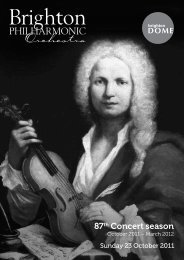Download Concert Programme - Brighton Philharmonic Orchestra
Download Concert Programme - Brighton Philharmonic Orchestra
Download Concert Programme - Brighton Philharmonic Orchestra
You also want an ePaper? Increase the reach of your titles
YUMPU automatically turns print PDFs into web optimized ePapers that Google loves.
BPO <strong>Programme</strong> (v2) 24 OCT 2010:Layout 1 24/10/10 08:55 Page 7<br />
his childhood<br />
years, gave him a<br />
sense of identity<br />
with the Danish<br />
soil. He distilled<br />
the essence of<br />
the Danish<br />
temperament in<br />
music with an<br />
unsentimental<br />
directness of<br />
expression. His<br />
music is<br />
disciplined, with<br />
constructive<br />
clarity as well as<br />
humanity and<br />
warmth.<br />
He was an independent thinker and it is<br />
totally in character that he developed an<br />
individual style that went against the<br />
trends of the day. He had a genuine<br />
concern for the integrity of his art,<br />
believing that a composer reveals himself<br />
through his music. He wrote about ‘the<br />
riddle of why music . . . both reveals and<br />
rewards its man [the composer]. If he aims<br />
high, it helps him . . . But if he is stupid,<br />
conceited, commonplace or sentimental,<br />
the fact will be revealed with almost brutal<br />
clarity.’<br />
Around the early 1900s Nielsen began to<br />
structure his works more on classical lines<br />
while continuing to draw on the late<br />
Romantic idiom, merging it with current<br />
trends in orchestration, chromaticism and<br />
atonality. His music can move from the<br />
calmly ecstatic to the tempestuous,<br />
sometimes quite suddenly. Such<br />
unpredictability is an inevitable aspect of<br />
his humanity. The emotional content is<br />
always easy to identify with, as one would<br />
expect from a man who felt himself to be<br />
just like any other man.<br />
Having composed his wind quintet in 1922,<br />
Nielsen planned a series of solo concertos<br />
for each of the wind quintet instruments.<br />
He managed to complete only two, one for<br />
flute and the other for clarinet. His preoccupation<br />
with the individuality of<br />
instruments is summed up in a statement<br />
he made around this time: ‘I think on the<br />
basis of the instruments themselves – in a<br />
way I creep into them. One can very well<br />
say that the instruments have a soul . . .’<br />
Nielsen completed the Flute <strong>Concert</strong>o in<br />
1926; it was premièred in Paris with Ravel<br />
and Honegger in the audience. The<br />
<strong>Concert</strong>o was written for Holger Gilbert<br />
Jespersen, a man who cherished<br />
refinement and hated vulgarity.<br />
Surprising therefore to find a bass<br />
trombone introduced into a ‘respectable’<br />
orchestra of Mozartian proportions. Was<br />
this Nielsen’s joke at Jespersen’s expense?<br />
The trombone attempts to disrupt the<br />
serious, pastoral mood of the opening –<br />
much to the flute’s evident chagrin.<br />
Sanity is restored and the flute alone and<br />
in dialogue with others (especially the<br />
clarinet) indulges in some exquisite<br />
passages of musical poetry. The second<br />
movement opens with an allegretto that<br />
alternates with a powerful adagio until<br />
the bass trombone interrupts once more<br />
with a march tune. In the brilliantly<br />
innovative conclusion the trombone<br />
assists the flute but has a final joke with<br />
some very ‘improper’ glissandi.
















